Results 1 to 2 of 2
Thread: Meprolight Mepro TRU-DOT RDS
-
9 April 2015, 13:44 #1
Meprolight Mepro TRU-DOT RDS
Around July of 2014 The MAKO Group began importing the Mepro TRU-DOT RDS manufactured by Meprolight which is located in Israel. I know, another red dot sight, but reviewing the specs, I knew I would be buying one eventually to test out.
First the manufacturer supplied info:
I ordered a RDS from Mako during their Black Friday sale, at the bonus price of about $287. Mako took about a month to ship the RDS and they have been experiencing some substantial issues with their ability to keep the RDS in stock, which has in part been to ongoing issues in Israel. They currently claim to have caught up with their back-orders and show the RDS in stock.The Mepro Tru-Dot® RDS is an energy-efficient, compact sight, that provides thousands of operating hours while utilizing a single "AA" commercial battery.
Featuring LED technology and rugged design, the sight assures reliability under the harshest environmental conditions.
With its large display window and clearly-defined Red-dot, the Mepro Tru-Dot® RDS ensures rapid target acquisition with both eyes open. Offering four easily switchable reticle brightness intensities, the Mepro Tru-Dot® RDS fits every scenario.
To facilitate night vision operations and long-rage target engagement, the Mepro Tru-Dot® RDS is compatible with GEN II and GEN III NVGs as well as with Magnifying Scopes.
Its human-engineering allows positioning of NVGs and Magnifiers close to the sight's optics with no decrease in the field-of-view and without compromising convenient switch operation.
* NVG Compatible.
* Durable & Lightweight.
* LED Technology for low power consumption.
* Auto Shut-off mechanism for additional energy savings.
* Four Distinct reticle brightness levels for different scenarios.
* Compatible with Magnifying Scopes.
* Large display window.
* Integral Picatinny Rail Adapter.
* Low-battery indicator.
* Minimal maintenance.
Technical Specifications & Features:
Magnification 1x
Display Window Dimensions 33 x 20 mm
Eye Relief unlimited
Red Dot Size 2MOA
Power Supply 1x AA Battery (Alkaline / Lithium)
Energy Saving System Auto shut-off / Auto power-resume
Dimensions (L x W x H) < 116 x 60 x 68 mm
Weight (With integral Picatinny, w/o battery) <300 g
Weapon Mount Integral Picatinny
Brightness Four variable brightness modes
Fully Sealed
I've been testing the RDS on a Troy Defense Bravo carbine exclusively, but test fit it on a few others as well. More on that in a bit.

Externally the RDS looks vaguely like an EOtech, but the single 1.8 MOA LED generated dot is more similar to that of an Aimpoint. The optic uses one of the most common battery types, a single AA. This should appeal to those that don't wish to stock extra CR123A, CR2032, DL1/3N or CR2 batteries that other optics use. The main housing is aluminum and the hood is polymer (the first few hundred had aluminum hoods).

The RDS has a built in mounting system for use on a 1913 Picatinny rail. Two adjustable tension levers clamp onto the rail and there is a single lug on the bottom of the RDS that locates in one of the slots in the rail. The lug on my unit measured at about .203" and the specs for the rail slot are .205" +/- .008". I found that there was a tiny bit of front to back play when I forcefully moved the optic back and forth on the rail. I could hear the lug hitting the edges of the slot. My first assumption was that the Troy upper rail section was out of spec, but I found the same movement when I tried it on others, to include Colt, S&W and MEGA. The rails slots were found to be within spec. The amount of movement was almost undetectable, but a phone call to Mako confirmed they had observed the same thing and were working on addressing it.

The battery compartment is easily accessible and does not require removal of the optic for replacement. The cap is tethered and the housing has a pictogram that shows the correct orientation of the battery.

Windage adjustments are on the front left side and elevation adjustments are on the front top of the RDS. The adjustments have distinct clicks and the adjustment dials are slotted for a coin (a nickel fits perfect) or flat blade screwdriver. Up and L arrows are positioned adjacent to the appropriate dials.

Weight on my scale with the AA battery installed came in at 10.8 ounces. For comparison, published specs for the Aimpoint PRO show 11.6 ounces with the mount and spacer and the EOTech XPS2 at 8 ounces, putting the RDS in the middle.
One of the features that really interested me was the automatic shut-off. This was different that the EOTech that powers down after 4 or 8 hours of no button pressing activity (depending on what button was last pushed). The RDS has a motion sensor built in which powers the unit off after 30 minutes of being totally motionless (initial information was 10 minutes, but testing showed it shut off at 30 minutes). This allows the user to have the illumination dial preset to the preferred brightness setting when stowed, but it immediacy powers up with the slightest movement (even a slight tap to the unit turned it on) . I've left the RDS on for the past four months and it has always immediately powered up for me, but today, I did experience a problem. I pulled in from it's stationary position, noted that the dot was there, but as I changed the intensity setting it died. I pulled the original supplied battery (Energizer Industrial Alkaline AA), put it back in and still no joy. I dropped in a new Energizer Lithium and all was well. As a side note, I had planned on eventually using AA lithium batteries exclusively in the RDS, since they are without doubt better for critical applications. They have a longer life, are lighter and don't leak like alkaline batteries. The manual indicates the dot is supposed to blink as a low battery indicator, but I did not observe this prior to it going dead. This was disappointing, given that the RDS has an advertised continuous on time of 15,000 hours at the highest setting. It will be interesting to see how the new battery performs.
Zeroing the RDS was simple. I followed the usual procedure of starting at 25 yards and moving the POI to about 1.5" low and then fine tuning at 50 yards. The 1.8 MOA dot appeared to me to be just about identical to the Aimpoint PRO 2 MOA dot. The large display window made it easy to pick the dot up, especially when shooting from unconventional positions where head placement behind the optic was not optimal. I noticed that the maximum brightness setting seemed to be slightly less intense than the Aimpoint PRO, even after the fresh battery was installed. There was a bit of a distracting reflection visible on the rear of the optic. Also observed was a bit of a halo around the dot, which disappeared in brighter outdoor conditions (not present on the Aimpoint PRO). The RDS is a lower 1/3, so that if the BUIS are in place, they are in view in the lower 1/3 of the window.
The four position rotary switch was easy to manipulate, but the dot that corresponds to the setting is on the side of the knob and not on the edge that is adjacent to the number, making it difficult to see what setting it's on if viewed directly from the back. The 0 setting is off. Position 1 is the brightest, 2 and 3 are progressively dimmer and 4 is NV. In comparison, the Aimpoint PRO starts out with 4 NV settings, then has 6 progressively brighter daylight settings.
Like many folks with astigmatism, when viewing the dot with uncorrected vision it wasn't perfectly round, more like a comma for me. It was better with corrected vision and better yet if viewed through the rear BUIS (this forces the eye to focus better).
I've been shooting the RDS for a few months, from 7 yards to 100 yards and as expected, groups were similar to other red dot or holographic optics. I did a series of shooting 5 round groups, 5 times, at 50 yards, removing and remounting the RDS between groups and did not notice any obvious POI shift.
Meprolight has a solid background building optics for the IDF. The RDS is closely related to the M5 Meprolight developed for the IDF and it retains many of the features and rugged construction. The RDS has an MSRP of $399, beating out the Aimpoint PRO by about $25 and the EOTech XPS2 by about $100. It's about twice the cost of a Vortex Strikefire II. These prices are estimates and street prices vary. The warranty is only 1 year which is less than Aimpoint at 2/10 years (2 years for professional/competition use, 10 for personal use) and EOTech at 2 years.
Overall, I'm pleased with the RDS. I'll keep an eye on the battery issue. It will be interesting to see if there will be an updated version at some time.

-
30 July 2015, 16:15 #2
A brief update. I ended up purchasing another RDS directly from MAKO a few months ago. It appeared to be identical to the earlier model with a couple exceptions. The on/off/brightness knob is now some type of polymer material and no longer metal. The dot intensity on the highest setting was very slightly dimmer.

I experienced similar mounting issues with this RDS, in that there was slight front to back movement on the upper when mounted on two different Colt rifles, despite the adjustment nuts being tightened. I continued test-fitting and found that it was a decent match for a Stag upper that was on hand. Off with the old Aimpoint C3 in an ARMS 17 mount and the RDS installed with no movement. At the range I removed and reinstalled it a few times and observed no POI shift.

MAKO fails to respond to email inquires about the mount issues, which is less than impressive, especially when trying to bring a new product to an established market.





 Reply With Quote
Reply With Quote

